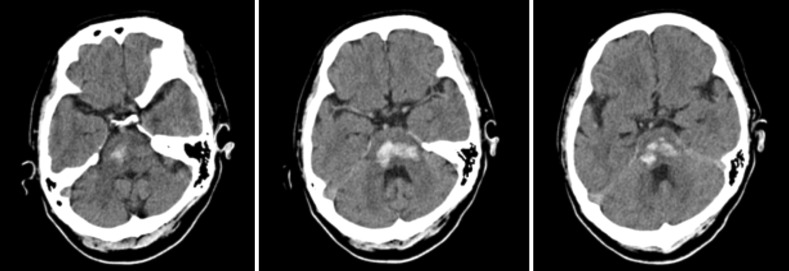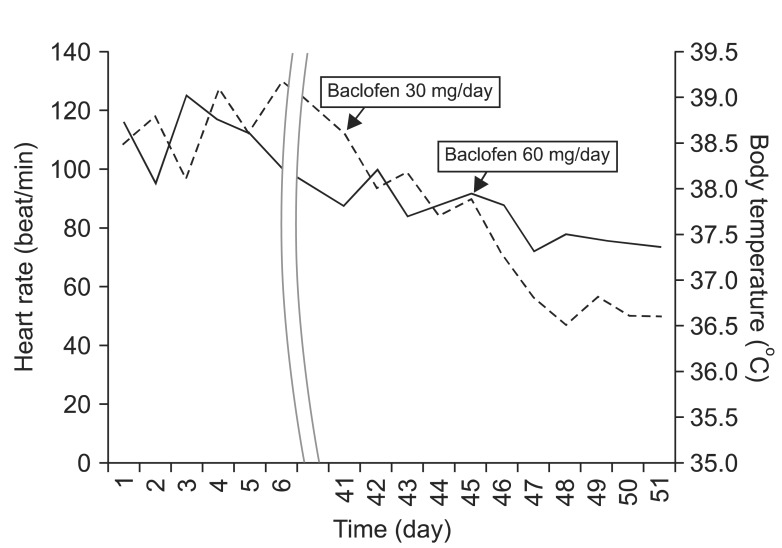Ann Rehabil Med.
2014 Apr;38(2):269-272.
Central Hyperthermia Treated With Baclofen for Patient With Pontine Hemorrhage
- Affiliations
-
- 1Department of Rehabilitation Medicine, Konkuk University School of Medicine, Chungju, Korea. kimnerve@hanmail.net
- 2Department of Neurology, Konkuk University School of Medicine, Chungju, Korea.
Abstract
- Central hyperthermia is a very rare disease; however, once it happens, it is associated with a poor prognosis and high mortality for patients with severe brainstem strokes. Following a pontine hemorrhage, a 46-years-old female developed prolonged hyperthermia. Work-ups to the fever gave no significant clues for the origin of fever, and hyperthermia did not respond to any empirical antibiotics or antipyretic agents. The patient's body temperature still fluctuated in a range of 37.5degrees C to 39.2degrees C. Considering the lesion of hemorrhage, we suspected central hyperthermia rather than infectious diseases. We started with baclofen administration at a dose of 30 mg/day. The body temperature changed to a range of 36.6degrees C to 38.2degrees C. We raised the dose of baclofen to 60 mg/day. The patient's body temperature finally dropped to a normal range. Central hyperthermia, caused by failures of thermoregulatory pathways in brainstem, following the pontine hemorrhage rarely occurs. Baclofen can be used to treat suspected central hyperthermia in a patient with pontine hemorrhage.
Keyword
MeSH Terms
Figure
Reference
-
1. Morales-Ortiz A, Jimenez-Pascual M, Perez-Vicente JA, Monge-Arguiles A, Bautista-Prados J. Fever of central origin during stroke. Rev Neurol. 2001; 32:1111–1114. PMID: 11562838.2. Sung CY, Lee TH, Chu NS. Central hyperthermia in acute stroke. Eur Neurol. 2009; 62:86–92. PMID: 19521083.
Article3. Wijdicks EF, St Louis E. Clinical profiles predictive of outcome in pontine hemorrhage. Neurology. 1997; 49:1342–1346. PMID: 9371919.
Article4. Huang YS, Hsiao MC, Lee M, Huang YC, Lee JD. Baclofen successfully abolished prolonged central hyperthermia in a patient with basilar artery occlusion. Acta Neurol Taiwan. 2009; 18:118–122. PMID: 19673364.5. Cannon B, Nedergaard J. Brown adipose tissue: function and physiological significance. Physiol Rev. 2004; 84:277–359. PMID: 14715917.
Article6. Imai-Matsumura K, Nakayama T. The central efferent mechanism of brown adipose tissue thermogenesis induced by preoptic cooling. Can J Physiol Pharmacol. 1987; 65:1299–1303. PMID: 3621079.
Article7. Boulant JA. Role of the preoptic-anterior hypothalamus in thermoregulation and fever. Clin Infect Dis. 2000; 31(Suppl 5):S157–S161. PMID: 11113018.
Article8. Amir S, Schiavetto A. Injection of prostaglandin E2 into the anterior hypothalamic preoptic area activates brown adipose tissue thermogenesis in the rat. Brain Res. 1990; 528:138–142. PMID: 2245331.
Article9. Shibata M, Iriki M, Arita J, Kiyohara T, Nakashima T, Miyata S, et al. Procaine microinjection into the lower midbrain increases brown fat and body temperatures in anesthetized rats. Brain Res. 1996; 716:171–179. PMID: 8738234.
Article10. Morrison SF, Sved AF, Passerin AM. GABA-mediated inhibition of raphe pallidus neurons regulates sympathetic outflow to brown adipose tissue. Am J Physiol. 1999; 276(2 Pt 2):R290–R297. PMID: 9950904.
- Full Text Links
- Actions
-
Cited
- CITED
-
- Close
- Share
- Similar articles
-
- Central Hyperthermia Due to Intracerebral Hemorrhage Treated with Baclofen: A Case Report
- Hyperthermia Plus Tachycardia Is Predictive of Fatal Outcome in Pontine Hemorrhage: A Case Report
- A Case of Auditory Neuropathy Caused by Pontine Hemorrhage in an Adult
- A Case Report of Acute Transient Encephalopathy Induced by Low Dose Baclofen
- Central Pontine Myelinolysis After Non-Aneurysmal Perimesencephalic Subarachnoid Hemorrhage: Case Report and Review of the Literature



